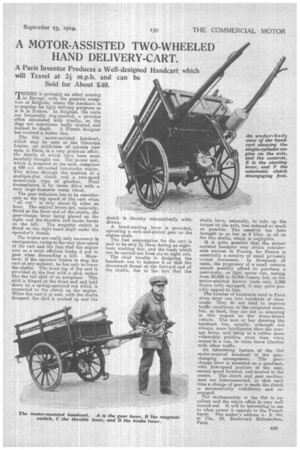A MOTOR-ASSISTED TWO-WHEELED HAND DELIVERY-CART.
Page 9

If you've noticed an error in this article please click here to report it so we can fix it.
A Paris Inventor Produces a Well-designed Handcart which will Travel at 2 m.p.h. and can be Sold for About £40.
THERE is probably a:to other country in Europe, with the possible exception of Belgaum, where the handcart is so popular far light delivery purposes as it is in France. In Belgium, the carts are frequently dog-assisted, a practice often associated with cruelty, as the
• dogs are sometimes badly treated and worked to death. A French designer has evolved a better idea.
The Ort motor-assisted handcart, which may be seen at the Concours Lapine, an exhibition of patents now open in Paris, is a very practical affair, the details of which have been most carefully thought out. The power unit, which is mounted on the axle, comprises a 650 c.c. air-cooled two-stroke engine. This drives through the medium of a multiple-disc clutch and a ;two-speed motorcycle type of gearbox. Final transmission is by worm drive with a very large-diameter worm wheel.
The gear reduction has to be considerable as the top speed of the cart when "all out" is only about 2 miles an hour. The control levers are, naturally, fitted at the front end of the shafts, the gear-change lever being placed on the right and the throttle and brake levers on the left. The magneto switch is fitted on the right-hand shaft under the operator's thumb.
The brakes are really only necessary in emergencies, owing to the very slow speed of the cart and the fact that the engine acts as a most efficient brake if put in
gear when descending a hill. Moreover, if the operator wishes to stop the cart. at any moment, he has only to lower the shafts. The front leg of the cart is provided at the foot with a skid, rather like the tail skid of an aeroplane. This skid is hinged at the front end and held down by a spring-operated rod which is eonnected to the clutch on the engine. When the cart. is at rest, with the shafts dropped, the skid is pushed up and the
clutch is thereby automatically withdrawn.
A hand-starting lever is provided, operating a rack-and-pinion gear on the engine shaft.
The fuel consumption for the cart is said to be only 3& litres during an eight. hour working day, and the ]ads which can be carried are from six to eight cwt. The chief trouble in designing the handcart. was to balance it so that the -downward thrust at the forward end of the shafts, due to the fact that the shafts have, naturally, to take up the torque on the axle, was reduced as much as possible. The reaction has been brought to as low as 4 kilos., in all on the two shafts, which is negligible.
It is quite possible that the motor: assisted handcart may attain considerable success in France, for France is essentially a country a small privately owned businesses, In thousands of cases, the proprietor of a small concern cannot possibly afford to purchase a camionette or light motor van, costing from 20,000 to 35,000 francs, but, as the motor-assisted barrow costs only 3,200 francs .fully equipped, it may quite possibly appeal to him.
The number of handcarts used in Paris alone must run into hundreds of thousands. They do not tend to improve traffic conditions in 'the congested areas, but, at-least, they are not so annoying in this respect as the horse-drawn vehicle. The man or boy drawing the handcart has, usually, although not always, more intelligence than the average horse, and being in a rather more vulnerable position afoot than when seated in a van, he takes fewer liberties with other traffic.
An interesting feature of the Ort motor-assisted handcart is the gearchanging arrangement. The gearchange lever is mounted on a quadrant, with first-speed position at the rear, second speed forward, and neutral in the centre. The clutch and gear mechanisms are interconnected, so that each time a change of gear is made the clutch is automatically withdrawn and reengaged. The workmanship in the Ort is excellent and the -whole affair is very well turned out. It will be interesting to see to what extent it appeals to the French buyer. The maker's address is : E. Ort et Cie., 28, Boulevard Malesherbes, Paris.
































